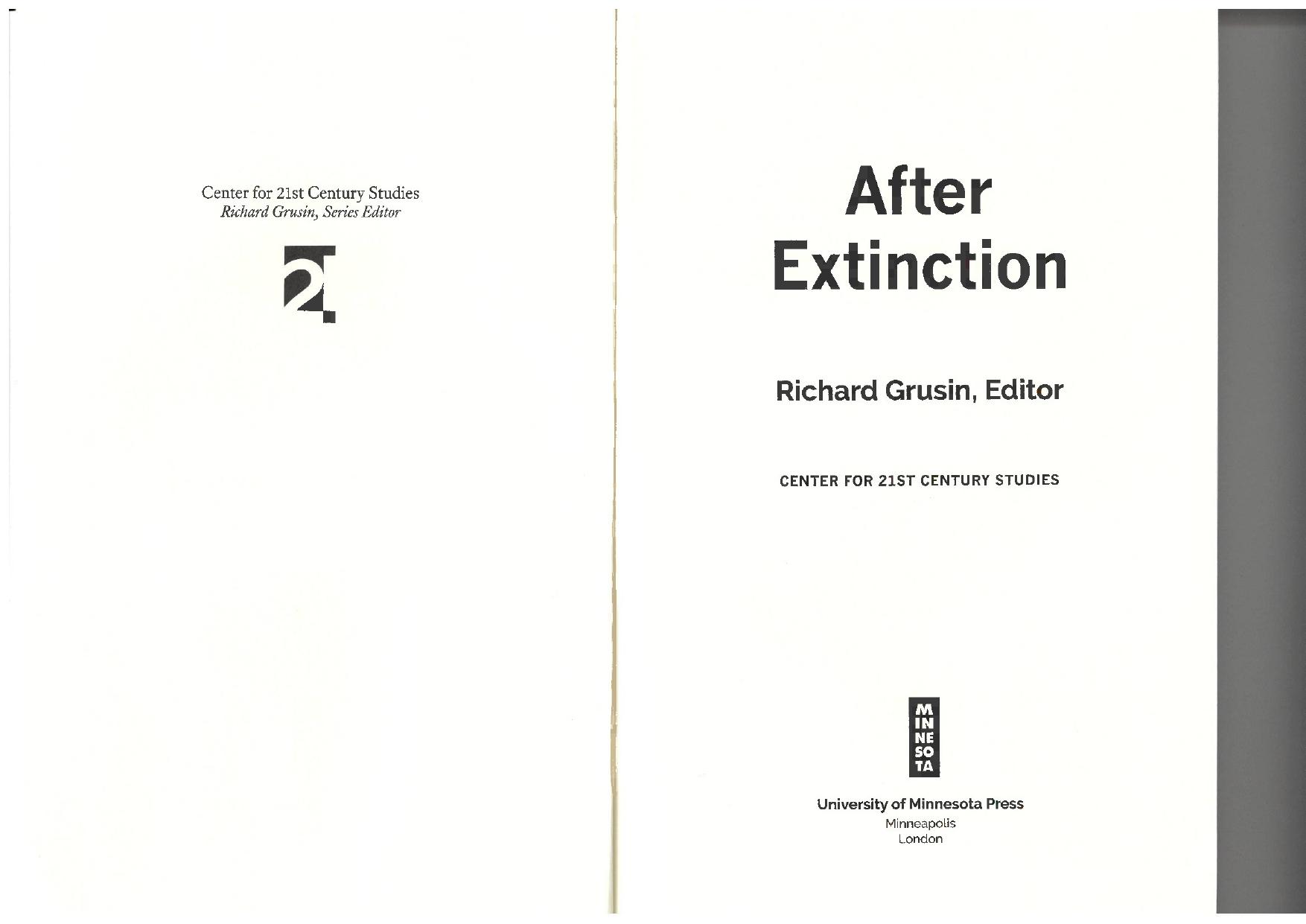After Extinction by Richard Grusin

Author:Richard Grusin
Language: eng
Format: epub, pdf
Published: 2018-04-06T23:14:26+00:00
A female hatched on the 23rd of May 1999 in Boise, Idaho. We released her back on
December 28th the same year. She was in the wild until 1st of February 2013 when
she died of lead poisoning. From the beginning of her time in the wild she was a real
problem. She had absolutely no fear of people and of course our concern with that
was that people might feed her. She turned out to be one of the best birds of the
population and she also produced young in the wild. So that’s a tough thing, losing
an adult, producing bird. A hard hit to the population . . . We thought if we would have
been able to track her we would have taken her and put her in captivity forever. She
was a bird that had absolutely no fear. Generally I would say that Condors don’t have
much fear of humans and that lack is one of our biggest problems. But we were ready
to catch her — she would land at the jewelry stands on the side of the highway and
she’d land near parked cars, probably because she had been fed; they’re certainly not
stupid. Then she turns out to be one of our best birds.
Figure 5.2. Bryndís Snæbjörnsdóttir and Mark Wilson. Condor 210, artwork from
the exhibition Trout Fishing in America and Other stories, Arizona State University
Art Museum, October 4, 2014, through January 17, 2015 (archival photograph,
2015). Courtesy of the artists.
120 CARY WOLFE
to make good on our commitments, to materialize our “world,” to ad-
dress the other to whom we feel responsible: an adestination that stems
from the fact that the same sign or trace or mark can function variably,
even oppositely, in very different contexts.22 The constraints of scientific method and protocol constitute, of course, a canonical attempt to control,
even eliminate, this destinerrance, but its most compelling manifestation
in this installation is the lead bullet that leaves its trace, sometimes in
the discoloration of the animal’s body by lead poisoning, but sometimes
invisible, in these bodies and these images but not of them, you might
say, the materialization of two “there s” in one “place.” That destinerrance
quite literally attends such tidy ethical, legal, and political distinctions
as we like to make between the polar opposites of “game” or “trash”
animals who are deemed “killable but not murderable”— the animals
that sustain these carrion feeders— and those who, like the condor, are
“rare,” “threatened,” and “protected,” with the full backing of scientific
and political apparatuses. The archive, in other words, may record the
“official story” of body weight, reproductive rate, legal status, and so on,
but it also actualizes something more, and in that other space, that other
scene, we discover that the world is not given but made. We thus discover,
in short, a scene of responsibility.
CONDORS AT THE END OF THE WORLD 121
Download
This site does not store any files on its server. We only index and link to content provided by other sites. Please contact the content providers to delete copyright contents if any and email us, we'll remove relevant links or contents immediately.
The remains of the day by Kazuo Ishiguro(7551)
Tools of Titans by Timothy Ferriss(6947)
The Black Swan by Nassim Nicholas Taleb(6192)
Inner Engineering: A Yogi's Guide to Joy by Sadhguru(5897)
Giovanni's Room by James Baldwin(5878)
The Way of Zen by Alan W. Watts(5800)
The Six Wives Of Henry VIII (WOMEN IN HISTORY) by Fraser Antonia(4790)
The Power of Now: A Guide to Spiritual Enlightenment by Eckhart Tolle(4755)
Astrophysics for People in a Hurry by Neil DeGrasse Tyson(4620)
Asking the Right Questions: A Guide to Critical Thinking by M. Neil Browne & Stuart M. Keeley(4576)
12 Rules for Life by Jordan B. Peterson(3734)
The Ethical Slut by Janet W. Hardy(3503)
Skin in the Game by Nassim Nicholas Taleb(3460)
Housekeeping by Marilynne Robinson(3401)
The Art of Happiness by The Dalai Lama(3384)
Double Down (Diary of a Wimpy Kid Book 11) by Jeff Kinney(3272)
Skin in the Game: Hidden Asymmetries in Daily Life by Nassim Nicholas Taleb(3264)
Walking by Henry David Thoreau(3234)
12 Rules for Life: An Antidote to Chaos by Jordan B. Peterson(3202)
